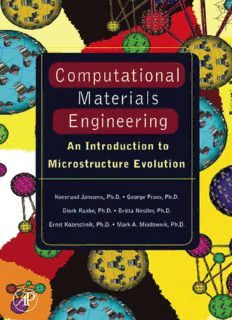Table Of ContentCOMPUTATIONAL
MATERIALS ENGINEERING
AnIntroductiontoMicrostructureEvolution
This page intentionally left blank
COMPUTATIONAL
MATERIALS ENGINEERING
An Introduction to Microstructure Evolution
KOENRAAD G. F. JANSSENS
DIERK RAABE
ERNST KOZESCHNIK
MARK A. MIODOWNIK
BRITTA NESTLER
AMSTERDAM•BOSTON•HEIDELBERG•LONDON
NEWYORK•OXFORD•PARIS•SANDIEGO
SANFRANCISCO•SINGAPORE•SYDNEY•TOKYO
AcademicPressisanimprintofElsevier
ElsevierAcademicPress
30CorporateDrive,Suite400,Burlington,MA01803,USA
525BStreet,Suite1900,SanDiego,California92101-4495,USA
84Theobald’sRoad,LondonWC1X8RR,UK
Thisbookisprintedonacid-freepaper. ∞
Copyright(cid:1)c 2007,ElsevierInc.Allrightsreserved.
Nopartofthispublicationmaybereproducedortransmittedinanyformorbyanymeans,electronicor
mechanical,includingphotocopy,recording,oranyinformationstorageandretrievalsystem,withoutpermission
inwritingfromthepublisher.
PermissionsmaybesoughtdirectlyfromElsevier’sScience&TechnologyRightsDepartmentinOxford,UK:
phone:(+44)1865843830,fax:(+44)1865853333,E-mail:permissions@elsevier.co.uk.Youmayalso
completeyourrequeston-lineviatheElsevierhomepage(http://elsevier.com),byselecting“CustomerSupport”
andthen“ObtainingPermissions.”
LibraryofCongressCataloging-in-PublicationData
Computationalmaterialsengineering:anintroductiontomicrostructureevolution/editorsKoenraadG.F.
Janssens...[etal.].
p.cm.
Includesbibliographicalreferencesandindex.
ISBN-13: 978-0-12-369468-3(alk.paper)
ISBN-10: 0-12-369468-X(alk.paper)
1.Crystals–Mathematicalmodels.2.Microstructure–Mathematicalmodels.3.Polycrystals–Mathematical
models.I.Janssens,KoenraadG.F.,1968-
TA418.9.C7C662007
548(cid:1).7–dc22
2007004697
BritishLibraryCataloguing-in-PublicationData
AcataloguerecordforthisbookisavailablefromtheBritishLibrary
ISBN13: 978-0-12-369468-3
ISBN10: 0-12-369468-X
ForallinformationonallElsevierAcademicPresspublications
visitourWebsiteatwww.books.elsevier.com
PrintedintheUnitedStatesofAmerica
07 08 09 10 11 12 10 9 8 7 6 5 4 3 2 1
toSu
This page intentionally left blank
Table of Contents
Preface xiii
1 Introduction 1
1.1 MicrostructuresDefined 1
1.2 MicrostructureEvolution 2
1.3 WhySimulateMicrostructureEvolution? 4
1.4 FurtherReading 5
1.4.1 OnMicrostructuresandTheirEvolutionfrom
aNoncomputationalPointofView 5
1.4.2 OnWhatIsNotTreatedinThisBook 6
2 ThermodynamicBasisofPhaseTransformations 7
2.1 ReversibleandIrreversibleThermodynamics 8
2.1.1 TheFirstLawofThermodynamics 8
2.1.2 TheGibbsEnergy 11
2.1.3 MolarQuantitiesandtheChemicalPotential 11
2.1.4 EntropyProductionandtheSecondLawof
Thermodynamics 12
2.1.5 DrivingForceforInternalProcesses 15
2.1.6 ConditionsforThermodynamicEquilibrium 16
2.2 SolutionThermodynamics 18
2.2.1 EntropyofMixing 19
2.2.2 TheIdealSolution 21
2.2.3 RegularSolutions 22
2.2.4 GeneralSolutionsinMultiphaseEquilibrium 25
2.2.5 TheDiluteSolutionLimit—Henry’sandRaoult’sLaw 27
2.2.6 TheChemicalDrivingForce 28
2.2.7 InfluenceofCurvatureandPressure 30
2.2.8 GeneralSolutionsandtheCALPHADFormalism 33
2.2.9 PracticalEvaluationofMulticomponentThermodynamic
Equilibrium 40
vii
3 MonteCarloPottsModel 47
3.1 Introduction 47
3.2 Two-StatePottsModel(IsingModel) 48
3.2.1 Hamiltonians 48
3.2.2 Dynamics(ProbabilityTransitionFunctions) 49
3.2.3 LatticeType 50
3.2.4 BoundaryConditions 51
3.2.5 TheVanillaAlgorithm 53
3.2.6 MotionbyCurvature 54
3.2.7 TheDynamicsofKinksandLedges 57
3.2.8 Temperature 61
3.2.9 BoundaryAnisotropy 62
3.2.10Summary 64
3.3 Q-StatePottsModel 64
3.3.1 UniformEnergiesandMobilities 65
3.3.2 Self-OrderingBehavior 67
3.3.3 BoundaryEnergy 68
3.3.4 BoundaryMobility 72
3.3.5 PinningSystems 75
3.3.6 StoredEnergy 77
3.3.7 Summary 80
3.4 Speed-UpAlgorithms 80
3.4.1 TheBoundary-SiteAlgorithm 81
3.4.2 TheN-FoldWayAlgorithm 82
3.4.3 ParallelAlgorithm 84
3.4.4 Summary 87
3.5 ApplicationsofthePottsModel 87
3.5.1 GrainGrowth 87
3.5.2 IncorporatingRealisticTexturesandMisorientation
Distributions 89
3.5.3 IncorporatingRealisticEnergiesandMobilities 92
3.5.4 ValidatingtheEnergyandMobilityImplementations 93
3.5.5 AnisotropicGrainGrowth 95
3.5.6 AbnormalGrainGrowth 98
3.5.7 Recrystallization 102
3.5.8 ZenerPinning 103
3.6 Summary 107
3.7 FinalRemarks 107
3.8 Acknowledgments 108
4 CellularAutomata 109
4.1 ADefinition 109
4.2 AOne-DimensionalIntroduction 109
4.2.1 One-DimensionalRecrystallization 111
4.2.2 BeforeMovingtoHigherDimensions 111
4.3 +2DCAModelingofRecrystallization 116
4.3.1 CA-NeighborhoodDefinitionsinTwoDimensions 116
4.3.2 TheInterfaceDiscretizationProblem 118
4.4 +2DCAModelingofGrainGrowth 123
viii TABLEOFCONTENTS
4.4.1 ApproximatingCurvatureinaCellularAutomatonGrid 124
4.5 AMathematicalFormulationofCellularAutomata 128
4.6 IrregularandShapelessCellularAutomata 129
4.6.1 IrregularShapelessCellularAutomataforGrainGrowth 131
4.6.2 InthePresenceofAdditionalDrivingForces 135
4.7 HybridCellularAutomataModeling 136
4.7.1 Principle 136
4.7.2 CaseExample 137
4.8 LatticeGasCellularAutomata 140
4.8.1 Principle—BooleanLGCA 140
4.8.2 BooleanLGCA—ExampleofApplication 142
4.9 NetworkCellularAutomata—ADevelopmentfortheFuture? 144
4.9.1 CombinedNetworkCellularAutomata 144
4.9.2 CNCAforMicrostructureEvolutionModeling 145
4.10FurtherReading 147
5 ModelingSolid-StateDiffusion 151
5.1 DiffusionMechanismsinCrystallineSolids 151
5.2 MicroscopicDiffusion 154
5.2.1 ThePrincipleofTimeReversal 154
5.2.2 ARandomWalkTreatment 155
5.2.3 Einstein’sEquation 157
5.3 MacroscopicDiffusion 160
5.3.1 PhenomenologicalLawsofDiffusion 160
5.3.2 SolutionstoFick’sSecondLaw 162
5.3.3 DiffusionForcesandAtomicMobility 164
5.3.4 InterdiffusionandtheKirkendallEffect 168
5.3.5 MulticomponentDiffusion 171
5.4 NumericalSolutionoftheDiffusionEquation 174
6 ModelingPrecipitationasaSharp-InterfacePhaseTransformation 179
6.1 StatisticalTheoryofPhaseTransformation 181
6.1.1 TheExtendedVolumeApproach—KJMAKinetics 181
6.2 Solid-StateNucleation 185
6.2.1 Introduction 185
6.2.2 MacroscopicTreatmentofNucleation—ClassicalNucleation
Theory 186
6.2.3 TransientNucleation 189
6.2.4 MulticomponentNucleation 191
6.2.5 TreatmentofInterfacialEnergies 194
6.3 Diffusion-ControlledPrecipitateGrowth 197
6.3.1 ProblemDefinition 199
6.3.2 Zener’sApproachforPlanarInterfaces 202
6.3.3 Quasi-staticApproachforSphericalPrecipitates 203
6.3.4 MovingBoundarySolutionforSphericalSymmetry 205
6.4 MultiparticlePrecipitationKinetics 206
6.4.1 TheNumericalKampmann–WagnerModel 206
6.4.2 TheSFFKModel—AMean-FieldApproachforComplex
Systems 209
6.5 ComparingtheGrowthKineticsofDifferentModels 215
TABLEOFCONTENTS ix
Description:•Balanced coverage of fundamentals of materials modeling, as well as more advanced aspects of modeling, such as modeling at all scales from the atomic to the molecular to the macro-material•Concise, yet rigorous mathematical coverage of such analytical tools as the Potts type Monte Carlo method,

